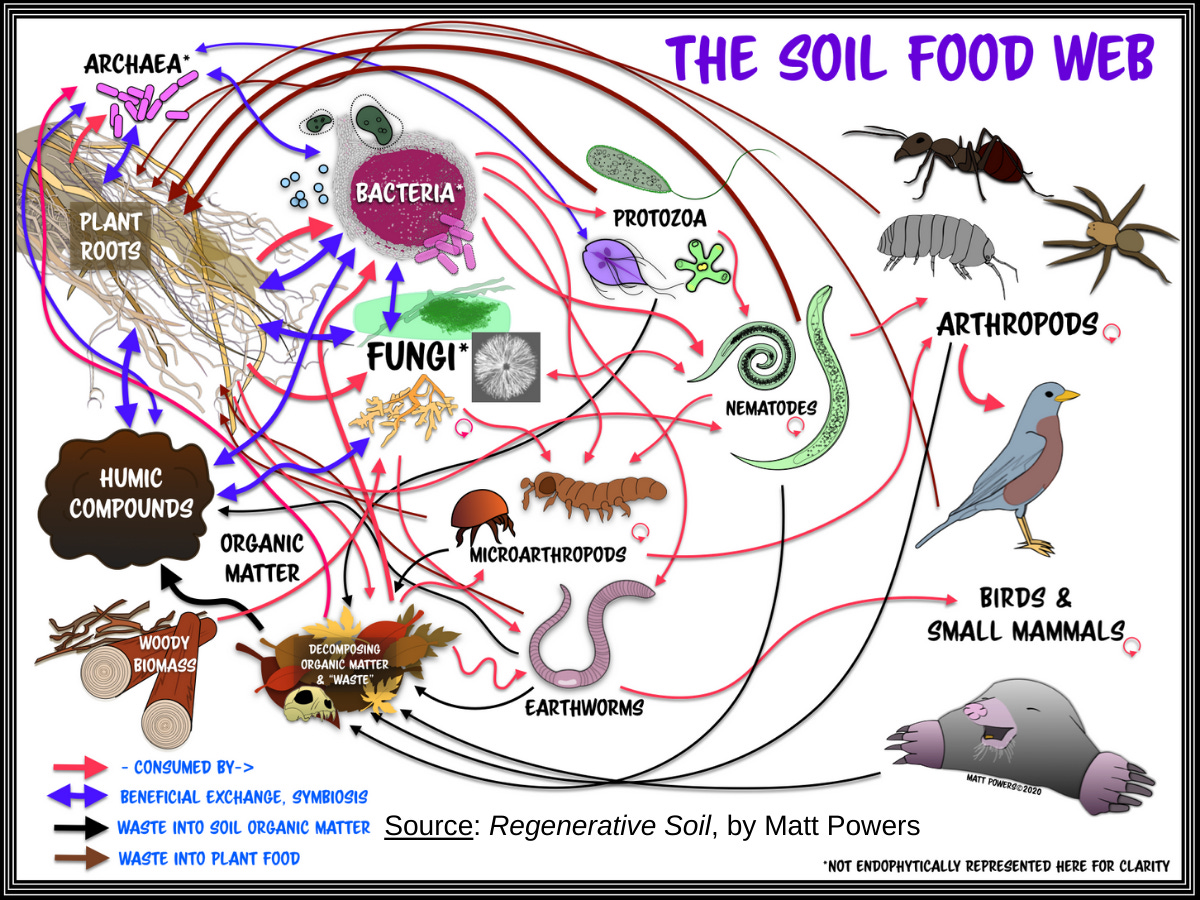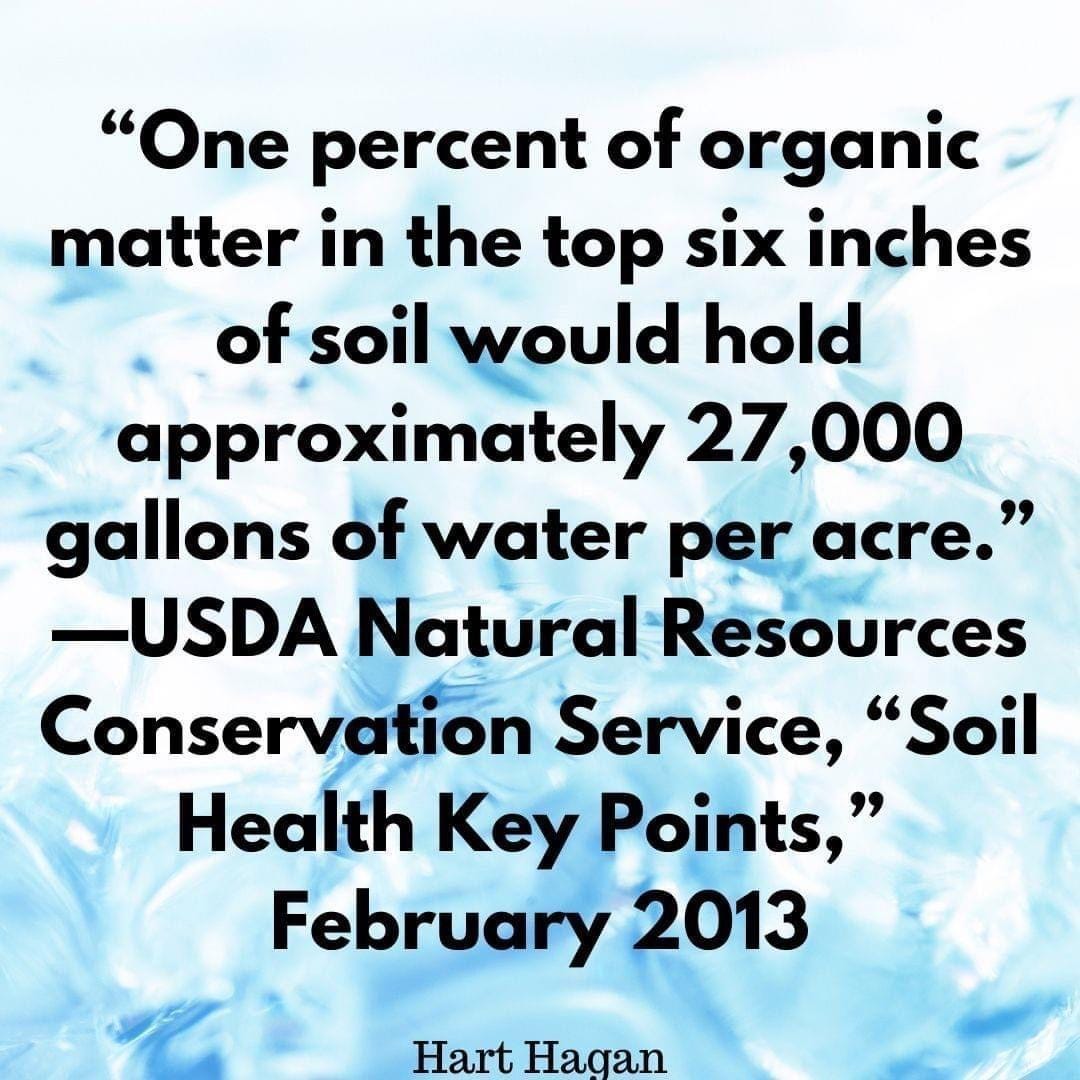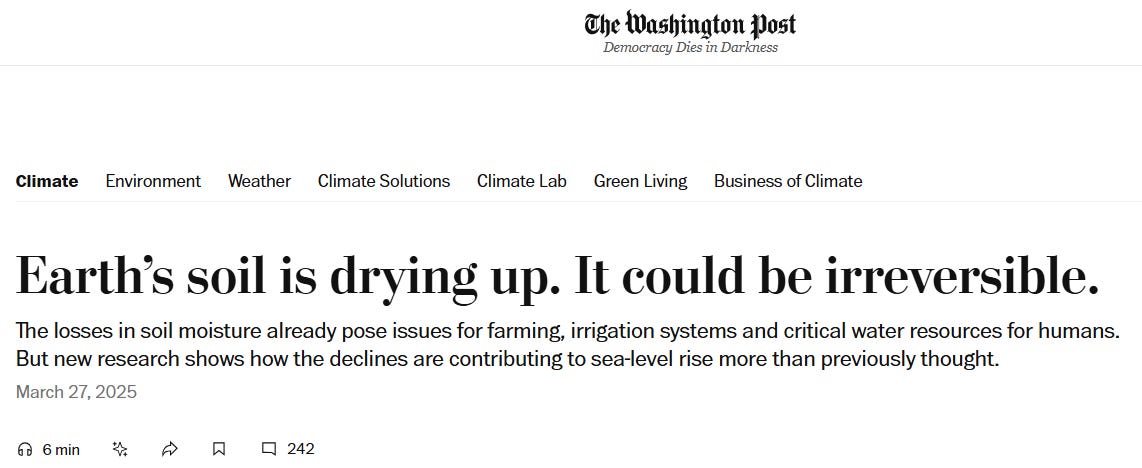The Soils of the World are Losing Massive Amounts of Moisture (Water)
The causes of the problem and the solutions are rather simple, but the scientists who report on the phenomenon seem oblivious
A March, 2025 study by Seo et. al. (Abrupt sea level rise and Earth’s gradual pole shift reveal permanent hydrological regime changes in the 21st century | Science) revealed a loss of 2,623 gigatons (a gigaton is a billion tons) of water from the soil over a 17-year period, from 2000 to 2016. This averages out to 154 gigatons per year of soil moisture (water) being lost from the soils of the world.
This is significant because it represents a loss of soil moisture is a loss of freshwater on which all but ocean life depends.
Huge Amounts of Water
This is a monumental amount of water by any standards. By comparison, only about 4.9 gigatons of carbon per year flow from the ground to the atmosphere, according to this graphic from Anastassia Makarieva.
If this is accurate, then the flow of freshwater from the soils annually is 30 times as much as the amount of carbon entering the atmosphere.
This may seem like comparing apples and oranges, but typically carbon and water flow in the same direction. They flow out of decaying ecosystems, and they flow together into growing ecosystems.
The Biggest Climate Story?
This deserves to be the biggest climate related story of the year.
How is this related to climate? We are talking about the loss of soil moisture from the climate. Soil moisture is good for the soil. And soil moisture is an indicator of healthy soil, because healthy soil holds water, and the water supports life in the soil.
Healthy Soil is the Solution to This Problem
The following graphic from Regenerative Soil, by Matt Powers, shows the major categories of creatures living in healthy soil.
These creatures make soil healthy, by adding soil organic matter, a spongy material that enables the soil to hold water.
How Soil Holds Water
According to the Natural Resources Conservation Service of the United States Department of Agriculture (USDA), for every 1% increase in soil organic matter in the top six inches of soil, the soil can hold an additional 27,000 gallons per acre.
Poor soil typically has less than 2% soil organic matter. Good soil can have 5% or more. What we do to the soil will either increase or decrease the soil organic matter and thereby increase or decrease the soil’s water holding capacity.
The(se particular) Scientists do Not Understand
The authors of the Seo study did not demonstrate any understanding of this phenomenon. In fact, when the Washington Post wrote about this article study, they declared that “it could be irreversible.”
But the problem of soil moisture loss is reversible. But you have to understand how soil works. You have to understand that although soils vary greatly from place to place, anything worthy to be called soil contains a supply of organic matter. If you treat it right, the soil will hold increasing amounts of organic matter, and will hold increasing amounts of water in the process.
How to Make Healthy Soil
This graphic summarizes the Five Principles of Soil health, as per Gabe Brown in his book Dirt to Soil.
According to this way of thinking, the way to make healthy soil, is to:
Limit disturbance, which means limit tillage and chemical fertilizers and pesticides
Armor the soil surface, which means don’t leave bare soil but use mulch or crop residues
Build diversity, which means employ a diversity of plants, which in turn generate diversity in the below-ground ecosystem, i.e., the soil food web.
Living roots in the ground means to plant cover crops, or otherwise allow plants to grow, because the plants pump carbon into the ground, and that’s the best thing for the soil.
Integrate animals means that if you’re a farmer, give livestock occasional access to the crop fields, or if you are a gardener, refrain from eradicating all animals from your environment. All ecosystems have animals, and the goal is to treat the farm or garden as an ecosystem, so that the soil can itself be an ecosystem.
Wherever you are and whatever your soil type, you can grow healthy soil, year by year.
If we do most of the above, our soil will hold more moisture. The problem is that we do the opposite of all these things in our landscapes, our farms and our forests.
Common Practices that Degrade Soil
These are common practices, in our farms, forests and landscapes:
We disturb the soil physically and chemically
We leave soil bare instead of covering it with mulch or crop residues
Instead of building diversity, we plant monocultures (one single species at a time) in our crop fields and in our forests
We leave ground bare when we could plant something or allow something to grow
We refuse livestock and wildlife access to the soil, where they would otherwise have a positive impact.
Instead of acting helpless as our soils lose organic matter and soil moisture, we could have national and international policies that encourage healthy soils that contain more organic matter and hold more water.
It’s just about that simple. The specifics vary from place to place. At one level, the soil is among the most complex phenomena on our planet. But building good soil is actually rather simple.
Here are Two Mysteries:
Why is the loss of soil moisture not a bigger climate story among media outlets that pretend to care about such things?
Why do the scientists who can quantify the worldwide loss of soil moisture not understand how the problem might be solved?
Check out the Water & Climate course, starting in July.
Water & Climate - Biodiversity for a Livable Climate
https://bio4climate.org/course-offerings/water-and-climate/?blm_aid=26405
The untold story of how water drives climate change … what climate models miss about the power of water.








Great article, thank you! The Global Carbon Cycle graphic is from the ESSD Global Carbon Budget reports they publish every year. Just wanted to give you the original source (there are also newer graphs now) in case this might be valuable for your future articles. Looking forward to the Water and Climate course. https://essd.copernicus.org/articles/17/965/2025/